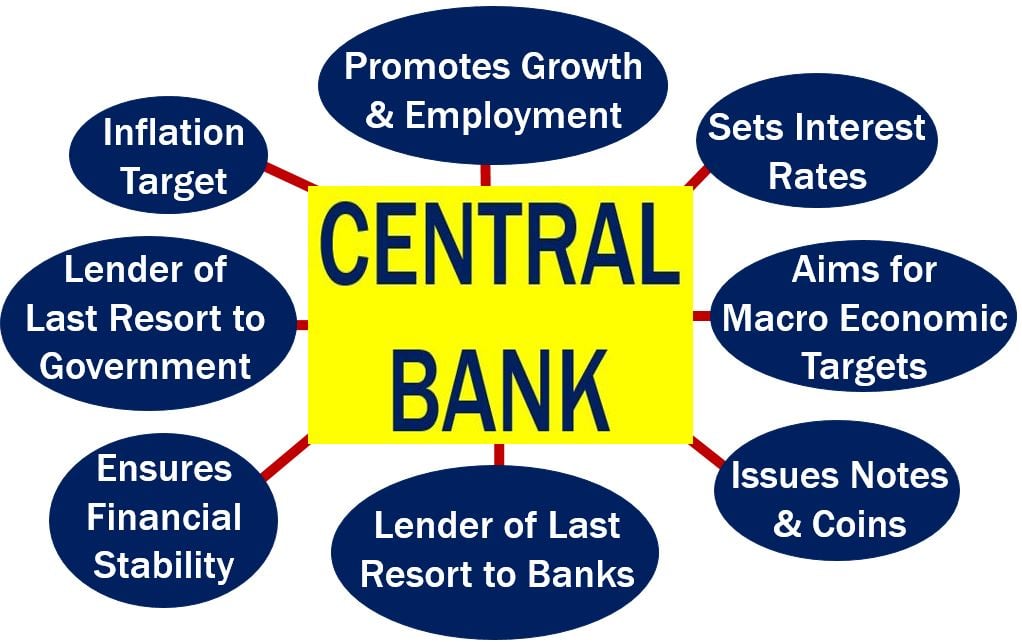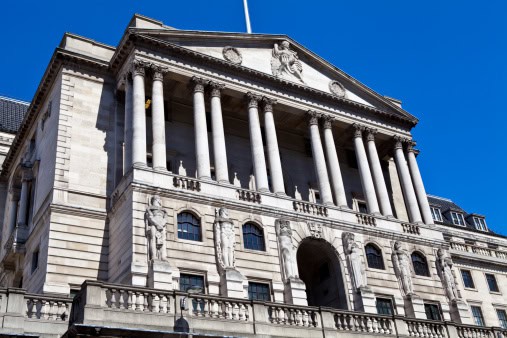Central bank – definition and meaning
A Central Bank, also known as a Reserve Bank, is the national economy’s primary financial institution. It is responsible for monetary policy, issuing currency (printing money), and overseeing the country’s banking system. It is in charge of how money operates in a country.
Some central banks, such as the ECB (European Central Bank), operate on behalf of a group of countries. The ECB is the central bank of the eurozone. The eurozone consists of twenty EU (European Union) countries that adopted the euro as their currency.
We refer to central banks as the ‘lenders of last resort.’ They must make sure there are enough funds in the economy when commercial banks cannot cover a money supply shortage.
Here are the names of some central banks: The Bank of England (UK), the Federal Reserve (US), the Bank of Canada (Canada), the Reserve Bank of Australia (Australia), the Reserve Bank of New Zealand (New Zealand), the Reserve Bank of India (India), the Bank of Japan (Japan), and the People’s Bank of China (China).
A brief history of central banks
Central banks have their roots in 17th-century Europe, starting with the establishment of the world’s first central bank, the Riksbank, in Sweden in 1668. This was soon followed by the creation of the Bank of England in 1694.
These financial institutions were founded to manage their countries’ currencies, stabilize the monetary system, and provide loans to the government. Over time, their roles expanded to include the regulation of the entire banking sector and the formulation of monetary policies.
As economies evolved and became more globalized, the importance and functions of central banks grew, cementing their pivotal role in today’s global economic framework.
The central bank and the banking system
Central banks have many responsibilities. They are in charge of a country’s currency, money supply, and interest rates. Also, they have the power to ensure that banks do not break the law.
They are also the ‘lender of last resort.’ In other words, they supply funds to desperate banks in an emergency. They try to prevent bank runs or bank failures.
A bank run occurs when many customers withdraw their money from a bank at the same time. A bank failure, on the other hand, occurs when a bank has become insolvent.
Through controlling the money supply, central banks aim to meet the government’s economic goals.

For example, when an economy is in trouble the central bank introduces monetary changes to help it recover.
Money is a scarce resource. A limited money supply, for example, can have a direct impact on employment rates and market growth.
When the economy is in trouble, central banks may step in and inject money. In other words, they increase the money supply.
The head of a central bank is the Governor, President, or Chairman.

Controlling the money supply
There are three main tools that central banks use to control money supply: First, the reserve requirement; second, open market operations; third, the discount rate.
-
Reserve requirement
The reserve requirement influences how much money the banking system can create with each dollar of reserve. An increase in the reserve requirement means that banks must hold more reserves.
This means that they can loan out less of each dollar that they have deposited. Subsequently, the money supply in the economy declines.
On the other hand, if the central banks decrease the reserve requirement, the opposite happens. Banks can then loan out more money per dollar. Therefore there is an increase in the money supply.
-
Open market operations
Through buying back government securities, central banks increase the total money that banks have. They subsequently increase money in circulation.
Conversely, by selling government securities, central banks decrease the money supply. As a result, banks reduce the amount of lending.
-
Discount rate
The discount rate is the interest rate on loans made to banks. In other words, the interest rate on loans made by the central bank to commercial banks.
When central banks lower discount rates the banking system borrows more from the central bank. There is, therefore, more money in circulation.
Central banks can influence the money supply by manipulating the discount rate.

Do governments control central banks?
Over recent years there has been less political control over the operations of central banks. Lawmakers today give central banks much more independence than they used to. This stems from the belief that too much political pressure may cause economic cycles.
‘Economic cycles’ refers to a process of economic expansion and contraction that occurs repeatedly.
Politicians often want to boost economic activity before an election. They care less about the long-term effects of suddenly boosting the economy than winning elections.
Central banks in the advanced economies and many emerging economies are independent. However, in democratic countries, the central bank is accountable at some level to the government.
Central bank sets targets
The central bank has the right to set its own targets and goals. It may focus on inflation, for example, or the money supply. Another central bank may place a high priority on maintaining the value of the country’s currency.
However, most of them prefer to announce their policy targets together with the relevant government departments. They believe it makes the policy setting process seem more transparent. By being transparent, they increase the credibility of the goals.
In advanced economies, central banks determine how to achieve their policy goals independently. They also have the authority to appoint staff, set budgets, etc.
According to the ECB (European Central Bank):
“A central bank is a public institution that manages the currency of a country or group of countries and controls the money supply.”
Video – What are Central Banks?

